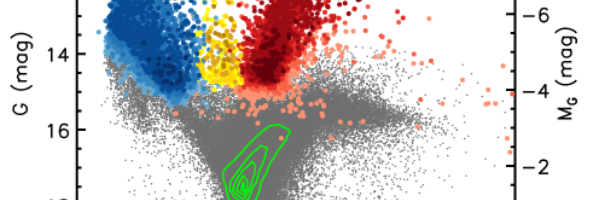Evolved Massive Stars at Low-metallicity III. A Source Catalog for the Large Magellanic Cloud
Ming Yang, Alceste Z. Bonanos, Biwei Jiang, Jian Gao, Panagiotis Gavras, Grigoris Maravelias, Shu Wang, Xiao-Dian Chen, Man I Lam, Yi Ren, Frank Tramper, Zoi T. Spetsieri
Abstract
We present a clean, magnitude-limited (IRAC1 or WISE1≤15.0 mag) multiwavelength source catalog for the LMC. The catalog was built upon crossmatching (1′′) and deblending (3′′) between the SEIP source list and Gaia DR2, with strict constraints on the Gaia astrometric solution to remove the foreground contamination. The catalog contains 197,004 targets in 52 different bands including 2 ultraviolet, 21 optical, and 29 infrared bands. Additional information about radial velocities and spectral/photometric classifications were collected from the literature. The bright end of our sample is mostly comprised of blue helium-burning stars (BHeBs) and red HeBs with inevitable contamination of main sequence stars at the blue end. After applying modified magnitude and color cuts based on previous studies, we identify and rank 2,974 RSG, 508 YSG, and 4,786 BSG candidates in the LMC in six CMDs. The comparison between the CMDs of the LMC and SMC indicates that the most distinct difference appears at the bright red end of the optical and near-infrared CMDs, where the cool evolved stars (e.g., RSGs, AGB, and RGs) are located, which is likely due to the effect of metallicity and SFH. Further quantitative comparison of colors of massive star candidates in equal absolute magnitude bins suggests that, there is basically no difference for the BSG candidates, but large discrepancy for the RSG candidates as LMC targets are redder than the SMC ones, which may be due to the combined effect of metallicity on both spectral type and mass-loss rate, and also the age effect. The Teff of massive star populations are also derived from reddening-free color of (J−KS)0. The Teff ranges are 3500<Teff<5000 K for RSG population, 5000<Teff<8000 K for YSG population, and Teff>8000 K for BSG population, with larger uncertainties towards the hotter stars.

